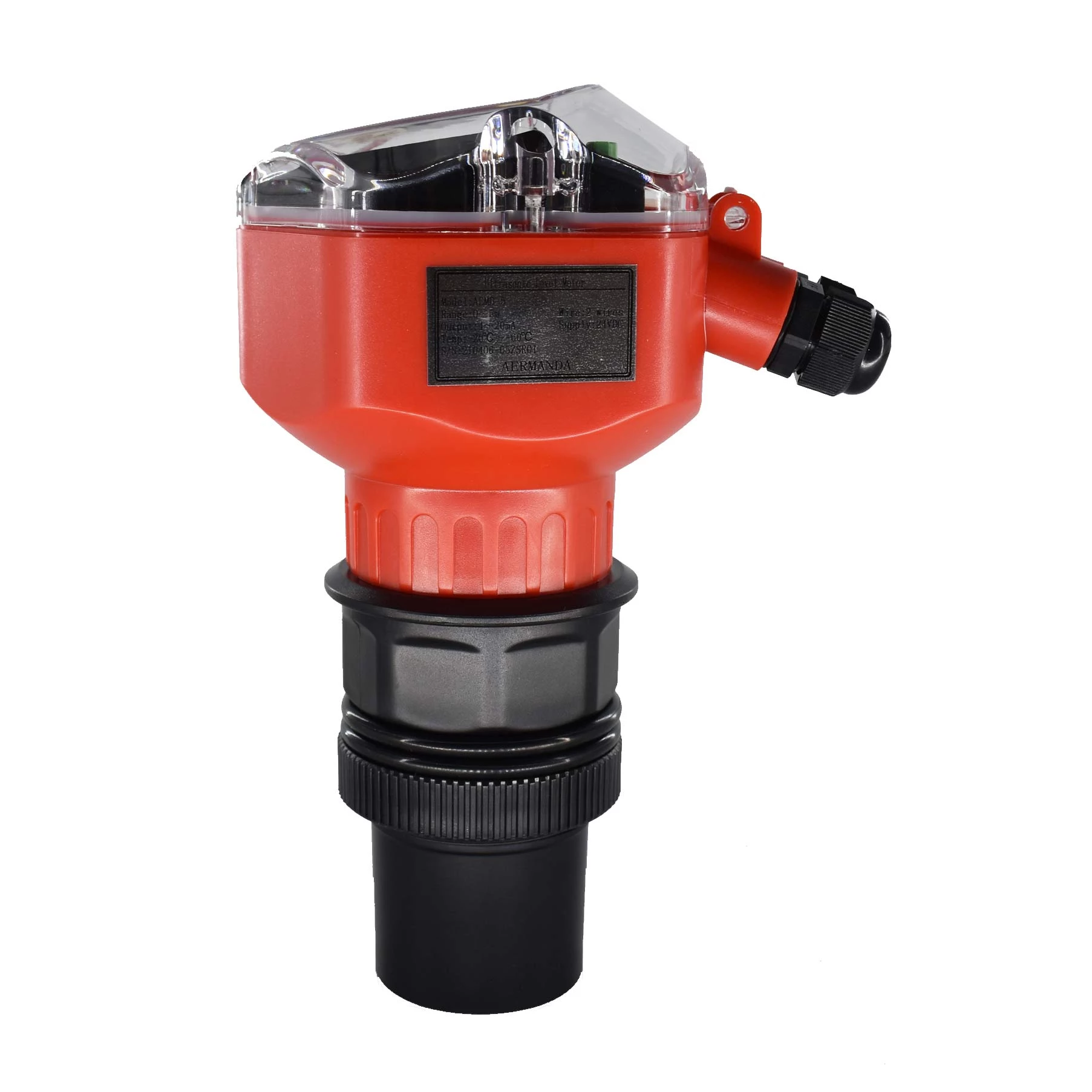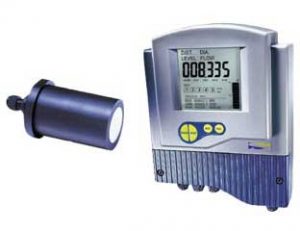Ultrasonic Level Transmitters
Sound is the sound we can hear, ultrasonic is a sound above the human hearing range, humans can hear up to a frequency of 20 kHz, ultrasonic frequencies are above 20 KHz.
Surface transmitters
Ultrasonic waves are used to measure the level of liquids and solids in industry. Measuring the surface with ultrasonic is basically non-contact and is more suitable for measuring the level of hot, corrosive and boiling liquids, the normal frequency range of the case. Use for ultrasonic level measurements in the range of 200-40 KHz.
1. What are the principles of ultrasonic surface measurement ?
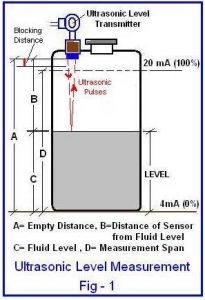
Ultrasonic transmitters
Ultrasonic waves detect an object in the same way that radar works.
Ultrasonic uses sound waves and radar uses radio waves.
When an ultrasonic pulse signal is routed to a target, it is reflected by the object and returned to the transmitter.
The time elapsed by the ultrasonic pulse is calculated and the distance of the object is found.
An ultrasonic surface transmitter is mounted on top of the semi-liquid tank. (figure 1)
The reference surface for all measurements is the bottom of the tank. The detected surface is indicated by C and B is the distance of the ultrasonic sensor from the liquid surface.
Ultrasonic pulse signals are transmitted from the transmitter and reflected and returned to the sensor.
The time taken by the ultrasonic pulse from the sensor to the target and its return is calculated.
Level C can be determined by multiplying half of this time by the speed of sound in air.
The unit of measurement of the final result can be in centimeters, feet, inches or…. Be.
2 – Problems of designing ultrasonic surface transmitter operating system
The principle of the above measurement seems to be quite correct in theory, in practice there are some technical problems that must be considered to read the surface correctly.
- The speed of sound changes due to changes in air temperature. An integrated temperature sensor is used to compensate for changes in sound speed due to temperature changes.
- A number of interfering echoes may be created by edges, welded joints, and so on. This is monitored by transmitter software and interference echo suppression is hoped for.
- Transmitter calibration is essential. The accuracy of the measurement depends on the accuracy of the calibration. The blank range A and the measuring distance D to enter the transmitter calibration must be specified correctly.
- The transient properties of the sensor create a blocking interval as shown in Figure 1. Distance D should never reach the Blocking distance.
3 – The main structure of an ultrasonic transducer
The ultrasonic heart sensor is an ultrasonic surface transmitter.
This sensor converts electrical energy into ultrasound waves.
Piezoelectric crystals are used for the conversion process.
Piezoelectric crystals oscillate at high frequencies when electrical energy is applied to them. The opposite is also true.
These piezoelectric crystals generate electrical signals when receiving ultrasound.
These sensors are able to send ultrasound to an object and receive an echo by the object.
This echo is converted into electrical energy by the control circuit to advance the process.
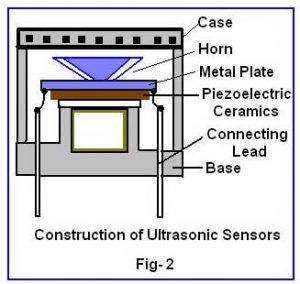
4- Diagram of an ultrasonic surface transmitter
A microcontroller based on the control circuit controls all the activities of the ultrasonic surface transmitter.
There are two pulse transmission circuits, one for the transmitter or transmitter pulse and one for the receiver pulse.
A pulse generated by a transmitter is a pulse that is converted into ultrasound pulses by an ultrasonic sensor (transmitter) and strikes an object.
This ultrasound pulse reflects an echo pulse to the ultrasonic sensor (receiver).
The receiver converts this ultrasonic pulse into an electrical signal pulse through a pulse generator.
Time elapsed or reflection time is measured by a counter.
This elapsed time is related to the area being measured.
This time spent by the control circuit is converted to a level.
There is a timing generator circuit that is used to synchronize all activities in the ultrasonic level measurement system.
Eventually the surface becomes a 20-4 mA signal.
4 mA corresponds to zero percent of the surface and 20 mA corresponds to 100% of the surface (see Figure 1).
This 4-20 mA output signal, which gives surface information, can be transmitted over long distances to process control devices. (Figure 3)
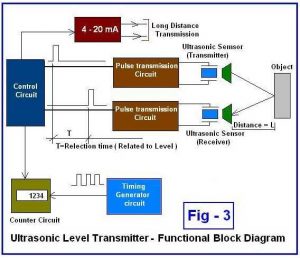
5. Advantages of ultrasonic surface transmitter
The ultrasonic surface transmitter has no moving parts and can measure the surface without physical contact with the object.
This transmitter feature is useful for measuring levels in tanks with corrosive, boiling and hazardous chemicals.
The reading accuracy remains the same even after changes in the chemical composition or dielectric constant of the material in the body process fluids.
6. Limitations of ultrasonic surface transmitter
Ultrasonic surface transmitters are the best level measuring devices in which the ultrasound received from the ultrasound is of acceptable quality.
This is not easy if the tank is deep and the echo is absorbed or dispersed. The object should not absorb sound.
Also unsuitable for tanks with very high smoke or high density moisture.
Features of 700 WL Ultrasonic Level Sensor
These 700 WL ultrasonic level sensors are not error sensitive due to the color, shape or composition of the target material (eg clear or opaque, liquid or solid).
Ultrasonic surface sensors are especially suitable for applications where a non-metallic object must be sensed in an environment where there is liquid, dust, heavy spray, food, ink or other environmental hazards.
Because ultrasonic surface sensors use sound energy for detection, the reflecting object should not be metal but can be glass, plastic, or even paper.
Immobile and non-turbulent liquids and solids containing large, hard particles are good reflectors and are therefore good candidates for measurement by ultrasonic surface sensors.
Wool and foam are poor reflectors, and dust or moisture in the steam room tends to absorb the pulses of ultrasonic surface sensors.
When these conditions are present, the pulses cannot be measured by ultrasonic surface sensors.
These sensors are stimulated by a pulse transmitter to generate a pressure wave and propagate to the target and then reflect the pulse.
The reflected wave is received by an ultrasonic surface sensor and converted into an electrical signal.
This electrical signal is then amplified and processed to find the reflected echo, and then calculated to find the distance to a specific target.
The distance is calculated with an object and then converted to a 4-20 mA signal by the sensor.
The following figure shows the structure of 700 WL ultrasonic surface sensors.
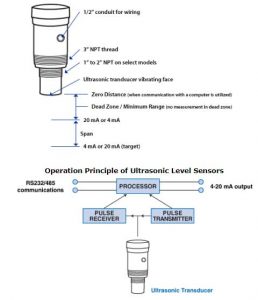
2-component non-contact ultrasonic surface transmitter
Smart Lite is a continuous contactless and ultrasonic surface measuring device that is able to provide accurate and precise measurements for liquids while automatically compensating for temperature changes and other environmental conditions.
Smart Lite level transmitter
Smart Lite is designed for applications such as process repositories, storage repositories, and more.
Smart Lite is a low voltage device with 4 wires and is available with a custom graphic LCD screen.
Smart Lite has two main components, the main control unit and the sensor.
Level transmitter features
- Installation in process tanks, storage tanks and….
- Self-adjusting for almost all types of situations
- Complete compensation in almost all environments: vapors, gases, temperature changes, wind and…. Provide the highest accuracy even under very harsh conditions
- Accuracy 0.25% of the measuring range
- For range up to 10 meters (32 feet)
- Resolution: 1 mm (0.04 inches)

